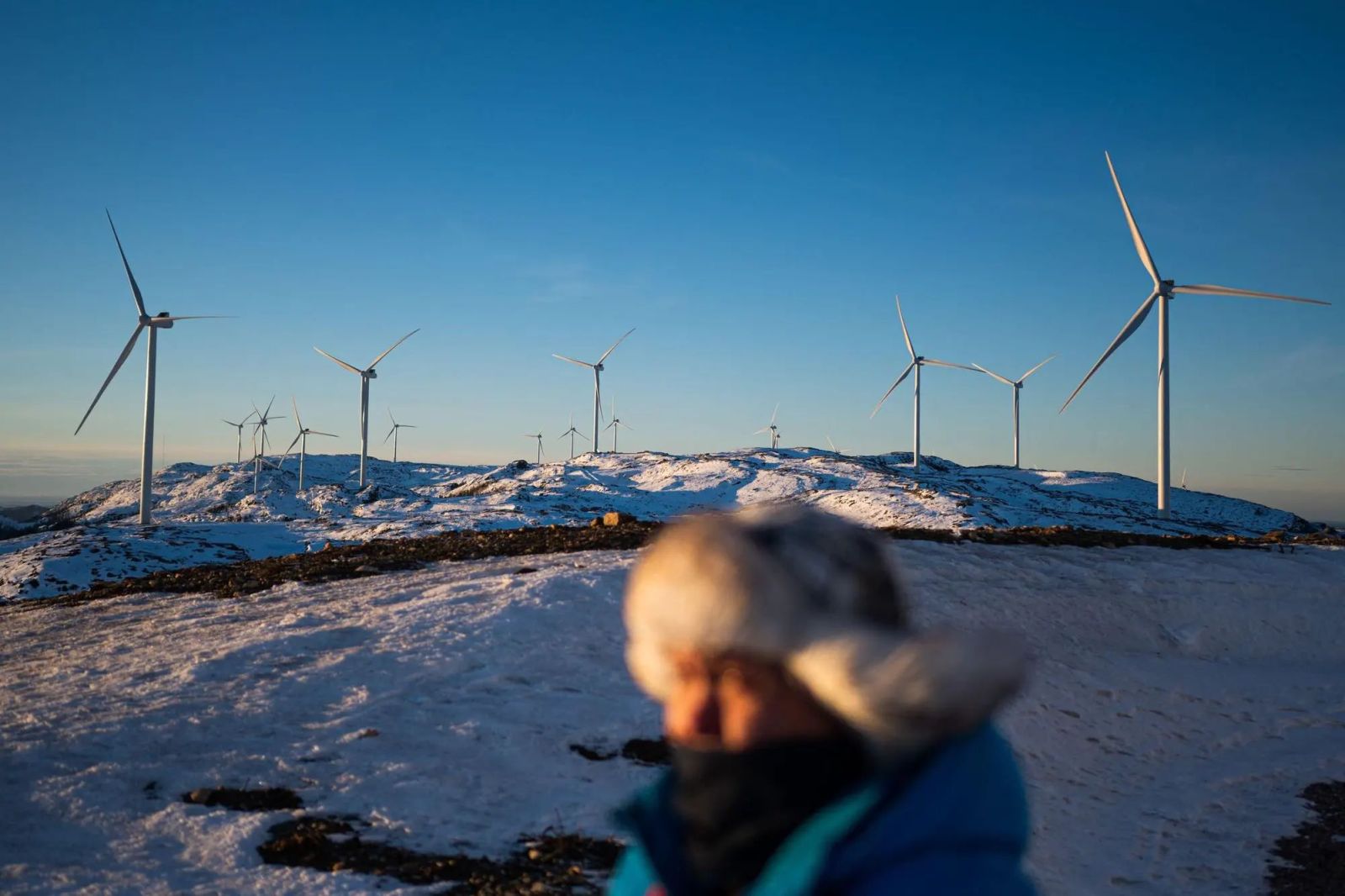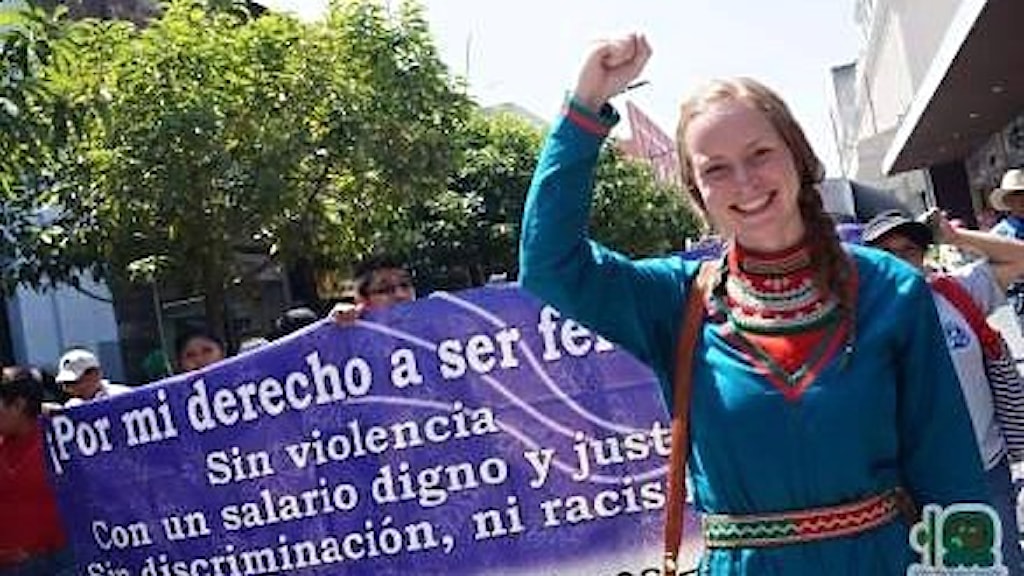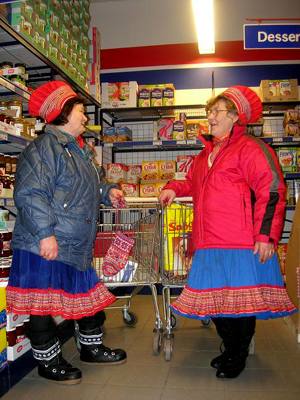Samis and Mapuche struggle against Statkraft wind farms
- Several projects by the Norwegian renewable giant have caused unrest in the Mapuche and Sami villages. Judges have also considered infrastructure illegal, but governments ignore it. Prominent human rights activists have also joined the protest, including Greta Thunberg.

These are 151 turbines, with connections and power lines over 130 kilometres on the Fos peninsula, north of Norway. Justice says they shouldn't be there, and that's what former caregivers and landowners say.
But it's not a chimera.
“The wind farm runs through the winter fodder pastures and cannot currently be used: snow deer will not approach the turbines. They have destroyed an old migration route that is fundamental to us,” explains María Puenchir. This 31-year-old human rights activist is well known in Norway. It is presented as “Queer, Sami and disabled” and receives an invitation to speak in the Norwegian parliament.
The bitter ones are also known as lapoi or saami, and they call their territory Sapmi. They are a people who do not know the borders. Less than 100,000 people currently live in Norway, Sweden, Finland and northern Russia. Puenchir has spoken to ARGIA from his home town, Trondheim. His house is very close to the Peninsula of the Fos, says that just thinking produces “pain and intense anger.”

The Fosen Vind region consists of four wind farms, one of the largest wind complexes in Europe. It has a capacity to generate 1,057 MW, enough to power 170,000 homes. Construction started in 2016. Cancellations, including those of the United Nations, were useless. The damage it would cause in the lives of the locals was known. Five years after the installation of the first turbine, in October 2021, the 11 judges of the Norwegian Supreme Court ruled that the infrastructure was illegal because it violated the development rights of the reindeer culture. In addition to fishing and agriculture, reindeer grazing is the economic livelihood of many houses. In Norway, the Sami community is the only one entitled to reindeer ownership because of its close relationship with its culture.
“Although the Supreme’s ruling is transparent, it did not clarify what had to be done with the turbines. They have not been dismantled and they also continue to function.”
On 30 January, Amnesty International launched the campaign to demand respect for judicial resolution and reparation for the “permanent violation of human rights”. On 23 February this year, in response to the administrative silence, a group of Sami youth decided to give the pulse to the Norwegian State: after four days of occupation of the offices of the Ministry of Oil, until they were dismissed by the police, they managed to block other ministries. On March 3, they finished their protest at the Royal Palace with a multitudinary sitting. The struggle continues.
.jpg)
“It was an initiative created by instagram,” says Puenchir. “Young people started counting days since the Norwegian Supreme Court ruling. When the count reached 500, seeing that the government did not make any movement, they went out into the street.”
Puenchir did not think twice to join them, nor did Greta Thunberg. The famous activist, from downtown Oslo, in full protest, spoke to ARGIA, "Why have I gotten closer? We are all witnesses to the plundering and exploitation of indigenous lands around the world. But we can see that resistance is also strong," the Swedish youth said on the phone. “Anyone who has the opportunity to support this kind of struggle would have to do so, at least I see it like this,” Thunberg stressed, and also called for “the end of Sapmiren colonization.”
On 2 March, the Samiak had the opportunity to hear the forgiveness of the Norwegian Government. The Oil and Energy Ministers, Terje Aasland, and Parliament President Samien, Silje Karine Muotka met. “Samie has spent a lot of time in a difficult and doubtful situation, and I really am sorry for them,” Aasland said. But the minister did not come up with any concrete solution. Parliament Samien was born in the 1990s and brings together community representatives from Norway, Sweden and Finland. In January 2021 it decided that any wind facility should be accepted by local sami communities and their elected representatives and that, if not, it should be cancelled.
At the moment, Oslo says that the wind energy project can join the reindeer grazing. Truth or not, there is a lack of a firm decision to clear the future of the controversial infrastructure.
.jpg)
According to data from the International Energy Agency, from the Arctic
to Wallmape, 98% of the Norwegian electricity supply comes from renewable energies. The six wind farms in the Fosen area generate more energy than the wind farms built across the country.
Despite the Swiss and German investment, 52% of the capital of the Fosengo project has been put on the table by the Norwegian company Statkraft. Answering the questions sent by ARGIA by e-mail, Statkraft underlines that the Supreme Court ruling does not mean that the licences of wind farms have expired, nor what should be done with the turbines. According to the company, the operation of the Fosen wind farm “can be maintained without irreparable damage to reindeer grazing”. To this end, the necessary measures must
be clarified for a new licence that “does not infringe the rights of the Sami people”. Finally, the company wishes to emphasize its concern and its “enthusiasm” so that the Sami people can “develop their culture as a guarantee of international law”.
On its website, Statkraft claims to be Europe’s largest renewable energy producer and “the global energy market company”. They say that in 21 countries they have 5,300 workers.

Complaints and rulings against the Norwegian energy giant also come from other continents. On 23 February, while protesting the Samis in central Oslo, Chilean police violently frustrated another protest against Statkraft. The demonstrators had in their sights the project of the Los Lagos power plant on the banks of the Pilmaiken River. “Maputxe is a place of great importance for the people. There is a complex ceremony in which there is a cemetery and, according to ancient beliefs, travel through the Pilmaiken River
so that the spirits keep their cycle after the death of their souls,” he explained to ARGIA by videoconference Fennix Delgado. A 35-year-old construction worker struggles from the Pilmaiken healthcare network. They have already managed to stop one of the three projects that Statkraft has in the same river.
In 2021, the Supreme Court of Chile judged the need for a popular consultation. A year later, this institution approved a request for support to the indigenous communities that rose up against Statkraft.
According to Delgado, Statkraft has never promoted dialogue. “Three small communities have received two awards. They want to understand that they have the approval of the locals, but the historical and legal truth is in our favor,” said the activist.

Mapuches have direct
knowledge of what is happening green colonialism in Norway and vice versa.
“The theft of indigenous lands in Chile and Norway is taking place before our eyes, always without the consent of local communities and leaving aside their cultural realities.”
These are the words of Eva Maria Fjellheim, a member of the Sami Council team, the largest civil society organisation in this country. He spoke to ARGIA by telephone and from Tromso, far north of Norway. Before continuing the dialogue, this tender 38-year-old woman wants to make one thing clear: “Although the Sami Council supports efforts to address the climate crisis, not all of them apply to the fundamental rights of peoples.”
In addition to his work in the Council, Fjellheim investigates for a doctoral degree at the Arctic University of Norway. “Green colonialism and the resistance of the Sami to the development of wind energy in their grazing lands” is the starting point and focus. It
says that the ancient knowledge and practices of indigenous peoples could be considered as part of the solution and not as an obstacle. The latter, Fjellheim, is the most common. The threat appears to be increasing for their fellow citizens. In addition to Norway, Sweden, Finland and Russia are promoting similar wind projects throughout the Samian territory.
“In respect of rights and sustainability, the Nordic countries want to be leaders, they defend that image. The Supreme Court’s last ruling against the Fos project, however, tells us otherwise,” says Fjellheim before opening the spotlight: “For many, human rights violations occur only in other regions and not in a democratic welfare state like Norway.”
Statkraft brings a debate to Euskal Herria

Text: Axier Lopez / Photo: Aitziber Arzallus - Uztarria Multinational norway proposed last year the construction of two wind farms in
Euskal Herria. The Basque Government and the municipalities are prepared to analyse the proposal. Both projects are currently under development. According to the information provided, 13 windmills of about 200 metres would be installed in the vicinity of the mountains. The largest of the two parks is Itsaraz: eight mills in the mountains between Aramaio and Eskoriatza to generate 60 megawatts. The second, called Piaspe, is planned for construction on Mount Sañoa, between Errexil, Zestoa and Azpeitia, to create 33 megawatts with five giants. These two Statkraft projects have caused a bustle because the debate on the need for renewables and the way nature is combined is still alive here.
Statkraft representatives participated in two public meetings organised by local governments (EH Bildu). In October they were at the Azpeti Soreasu Theatre and in November at the Casa de Cultura de Aramaio. In both cases the room was filled to the maximum and the tension was very present in the environment.
In Aramaio, representatives of the Norwegian company stressed that studies to measure the impact of the park on the environment and biodiversity are still ongoing. The citizens put on the table the damage caused to the bitter and Mapuche by the projects of Statkraft, questioning the veracity of the research they will carry out in the Basque Country. The representatives of the multinational assured that the value of the energy that Itsaraz will generate, both qualitative and quantitative, still do not know.
In Azpeitia the session was extended for two and a half hours and citizens showed their concerns and disagreements. Applause on the one hand and on the other, shouts and outcry. The municipal representatives indicated that although the park would be outside the legally protected natural spaces, they will study in depth their possible affection to heritage, the environment or the landscape. Statkraft’s representatives stressed that with 205 metre tall windmills they would cover 50% of Urola Erdia’s energy consumption. If the project went ahead, the project would be completed by the end of 2026 or early 2027. Citizenship asked many questions and criticisms. “It seems that you have come to save us. The model is the same, you are a company that comes from outside, that sees that here is a place to get the business out, and period,” one person said. “Is the amount of energy we get from wind farms worth leaving the mountains in awe?” They also came to the international eye: “What will be the picture in the places where they have to take metals out to make windmills?” “We live people on the mountain, we have many more votes in the cities, but those of us on the mountain cook and take care of the mountain,” one farmer explained.
30 urteren ondoren, Gallivareko (Suedia) tribunal batek Zirkulu Polarrean dagoen Girjaseko sami herri indigenari eman dio beraien herrialdean arrantzatzeko eta ehizatzeko eskubidea. Garan irakur daitekeenez, 1993. urtean kendu zieten eskubidea berreskuratu du komunitateak. Dena... [+]
Suedia iparraldean bizi diren samiak burdina ustiatzeko ireki nahi duten meategi baten aurka ari dira borrokan. Atzo 50 pertsonaz osatutako protesta desegin zuen poliziak eta zortzi atxilotu zituen.
Duela urte asko, samien herri indigena nahi bezala bizi zen eskandinaviar penintsularen iparraldean. Naturarekin bat, bizia elur-oreinen zaintza eta arrantzaren inguruan egiten zuten gehienbat. Lurrak emandakoari ahalik eta probetxurik gehien atereaz, beren sinesmenekin lasai... [+]
Mari Boine artista sami ezagun eta errespetatuena da. Samiak Norvegia, Suedia, Finlandia eta Errusia iparraldean bizi diren indigenak dira, eta diskriminazio garai zaharrak atzean utzi badituzte ere, nahikoa lan badute euren hizkuntzari eusten (egun, datu zehatzik ez bada ere,... [+]
Duela urte asko, samien herri indigena nahi bezala bizi zen eskandinaviar penintsularen iparraldean. Naturarekin bat, bizia elur-oreinen zaintza eta arrantzaren inguruan egiten zuten gehienbat. Lurrak emandakoari ahalik eta probetxurik gehien atereaz, beren sinesmenekin lasai... [+]



















